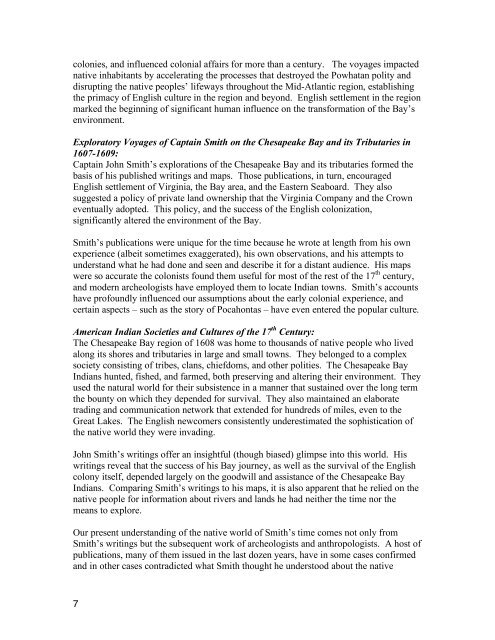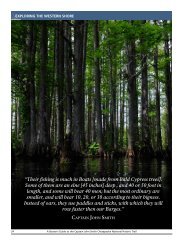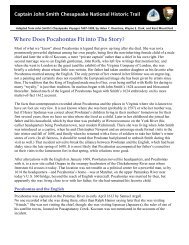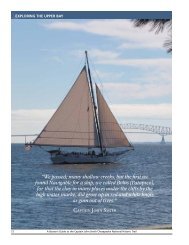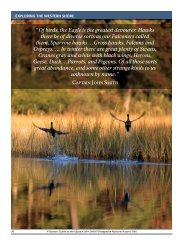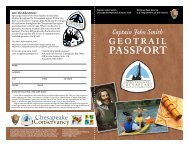Draft Interpretive Plan Join the adventure! - Captain John Smith ...
Draft Interpretive Plan Join the adventure! - Captain John Smith ...
Draft Interpretive Plan Join the adventure! - Captain John Smith ...
You also want an ePaper? Increase the reach of your titles
YUMPU automatically turns print PDFs into web optimized ePapers that Google loves.
colonies, and influenced colonial affairs for more than a century. The voyages impacted<br />
native inhabitants by accelerating <strong>the</strong> processes that destroyed <strong>the</strong> Powhatan polity and<br />
disrupting <strong>the</strong> native peoples’ lifeways throughout <strong>the</strong> Mid-Atlantic region, establishing<br />
<strong>the</strong> primacy of English culture in <strong>the</strong> region and beyond. English settlement in <strong>the</strong> region<br />
marked <strong>the</strong> beginning of significant human influence on <strong>the</strong> transformation of <strong>the</strong> Bay’s<br />
environment.<br />
Exploratory Voyages of <strong>Captain</strong> <strong>Smith</strong> on <strong>the</strong> Chesapeake Bay and its Tributaries in<br />
1607-1609:<br />
<strong>Captain</strong> <strong>John</strong> <strong>Smith</strong>’s explorations of <strong>the</strong> Chesapeake Bay and its tributaries formed <strong>the</strong><br />
basis of his published writings and maps. Those publications, in turn, encouraged<br />
English settlement of Virginia, <strong>the</strong> Bay area, and <strong>the</strong> Eastern Seaboard. They also<br />
suggested a policy of private land ownership that <strong>the</strong> Virginia Company and <strong>the</strong> Crown<br />
eventually adopted. This policy, and <strong>the</strong> success of <strong>the</strong> English colonization,<br />
significantly altered <strong>the</strong> environment of <strong>the</strong> Bay.<br />
<strong>Smith</strong>’s publications were unique for <strong>the</strong> time because he wrote at length from his own<br />
experience (albeit sometimes exaggerated), his own observations, and his attempts to<br />
understand what he had done and seen and describe it for a distant audience. His maps<br />
were so accurate <strong>the</strong> colonists found <strong>the</strong>m useful for most of <strong>the</strong> rest of <strong>the</strong> 17 th century,<br />
and modern archeologists have employed <strong>the</strong>m to locate Indian towns. <strong>Smith</strong>’s accounts<br />
have profoundly influenced our assumptions about <strong>the</strong> early colonial experience, and<br />
certain aspects – such as <strong>the</strong> story of Pocahontas – have even entered <strong>the</strong> popular culture.<br />
American Indian Societies and Cultures of <strong>the</strong> 17 th Century:<br />
The Chesapeake Bay region of 1608 was home to thousands of native people who lived<br />
along its shores and tributaries in large and small towns. They belonged to a complex<br />
society consisting of tribes, clans, chiefdoms, and o<strong>the</strong>r polities. The Chesapeake Bay<br />
Indians hunted, fished, and farmed, both preserving and altering <strong>the</strong>ir environment. They<br />
used <strong>the</strong> natural world for <strong>the</strong>ir subsistence in a manner that sustained over <strong>the</strong> long term<br />
<strong>the</strong> bounty on which <strong>the</strong>y depended for survival. They also maintained an elaborate<br />
trading and communication network that extended for hundreds of miles, even to <strong>the</strong><br />
Great Lakes. The English newcomers consistently underestimated <strong>the</strong> sophistication of<br />
<strong>the</strong> native world <strong>the</strong>y were invading.<br />
<strong>John</strong> <strong>Smith</strong>’s writings offer an insightful (though biased) glimpse into this world. His<br />
writings reveal that <strong>the</strong> success of his Bay journey, as well as <strong>the</strong> survival of <strong>the</strong> English<br />
colony itself, depended largely on <strong>the</strong> goodwill and assistance of <strong>the</strong> Chesapeake Bay<br />
Indians. Comparing <strong>Smith</strong>’s writings to his maps, it is also apparent that he relied on <strong>the</strong><br />
native people for information about rivers and lands he had nei<strong>the</strong>r <strong>the</strong> time nor <strong>the</strong><br />
means to explore.<br />
Our present understanding of <strong>the</strong> native world of <strong>Smith</strong>’s time comes not only from<br />
<strong>Smith</strong>’s writings but <strong>the</strong> subsequent work of archeologists and anthropologists. A host of<br />
publications, many of <strong>the</strong>m issued in <strong>the</strong> last dozen years, have in some cases confirmed<br />
and in o<strong>the</strong>r cases contradicted what <strong>Smith</strong> thought he understood about <strong>the</strong> native<br />
7


